Difference between revisions of "Studio camera"
m (not realistic to state as fact that digital will never match large format) |
(→What else is studio camera?: pic) |
||
| (12 intermediate revisions by 3 users not shown) | |||
| Line 1: | Line 1: | ||
===Prologue: Photo Studio=== | ===Prologue: Photo Studio=== | ||
| − | Photography needs light. In the early times of [[photography]] the rule ''photography needs time and light'' was more obvious since the exposure times for portraits were at least 5 seconds. To achieve such "short" exposure times a well | + | Photography needs light. In the early times of [[photography]] the rule ''photography needs time and light'' was more obvious since the exposure times for portraits were at least 5 seconds. To achieve such "short" exposure times a well-lit scene had to be chosen to make a picture of a person. Thus early professional photo studios had large glass windows facing towards the midday sun. Optimal studio rooms were under the roof, with additional big glass windows in the roof bringing full advantage of bright daylight. |
| − | But photographers were not happy: | + | But photographers were not happy: with sunny weather outside they could make a [[Daguerreotype]] exposure within five seconds; with dark clouds over the studio at least 20 seconds were necessary, especially a problem when portraying children. "Head-holders" and other means of "torture" were not the solution. The invention of new faster [[:Category:Photographic processes|photographic processes]] together with the invention of the [[flashgun]] were solving the time&light problem. Electric light, electric [[flashbulbs]], and later electronic flashguns dramatically enhanced the advantages of photographing in a studio since the light there became completely controllable by the [[photographer]], and of course always bright enough to forget about ancient exposure time troubles. |
{{Flickr image | {{Flickr image | ||
| − | | image_source=http://www.flickr.com/photos/89864432@N00/3200307664/in/pool- | + | | image_source=http://www.flickr.com/photos/89864432@N00/3200307664/in/pool-camerawiki |
| image=http://farm4.static.flickr.com/3127/3200307664_bb014b13c5.jpg | | image=http://farm4.static.flickr.com/3127/3200307664_bb014b13c5.jpg | ||
| image_align=left | | image_align=left | ||
| Line 10: | Line 10: | ||
}} | }} | ||
===What about the cameras?=== | ===What about the cameras?=== | ||
| − | The cameras needed in the ancient daylight-depending studios had to have fast lenses. The fast [[Petzval lens]] was a standard for portrait photography. With the fast [[lens]]es used at wide [[aperture]] the still | + | The cameras needed in the ancient daylight-depending studios had to have fast lenses. The fast [[Petzval lens]] was a standard for portrait photography. With the fast [[lens]]es used at wide [[aperture]]s the still portraying style was found: sharpness plane on the face and blurred foreground and background. Big cameras were not necessary. |
| − | But the photographers wanted to show all their art, thus giving their studios the style of a theatre stage with changing | + | But the photographers wanted to show all their art, thus giving their studios the style of a theatre stage with changing settings. The photo subjects could feel like actors on a stage, playing a scene with statuary gesture for the moment of exposure, of course made at smaller aperture, needing a longer exposure time unless made with flash light. If people wanted , instead of a picture for the album, a big framed image for the living room, [[large format]] cameras were preferred instead of costly enlarging of small images. Thus big [[view camera]]s have become common in photo studios. If such cameras reach dimensions at which they must be seen as a piece of studio furniture they are pure '''studio cameras'''. The camera stand of such a camera is not just a [[tripod]]. It is a sturdy massive wooden construction including mechanics to regulate height and tilting of the camera. |
Studio cameras might give exposures of 8×10 inches or dimensions like that, thus giving highest possible image [[resolution]] if taken ultimately sharp. | Studio cameras might give exposures of 8×10 inches or dimensions like that, thus giving highest possible image [[resolution]] if taken ultimately sharp. | ||
| − | With the advent of high-end professional digital | + | With the advent of high-end professional [[digital camera]]s, large format studio cameras are rarely seen in use anymore. However, a large format camera still can achieve greater quality than present studio digital cameras can hope for. |
| + | {{br}} | ||
| + | {|class=plainlinks | ||
| + | ||[http://www.flickr.com/photos/89864432@N00/3695980252/in/pool-camerawiki/ http://farm3.static.flickr.com/2427/3695980252_926932a401.jpg] | ||
| + | ||[http://www.flickr.com/photos/89864432@N00/3695980242/in/pool-camerawiki http://farm3.static.flickr.com/2503/3695980242_fb025fcc32.jpg]<br/> | ||
| + | {{Flickr_image_caption | ||
| + | |image_text= <small>A studio camera of the same type as the one in the illustration above. The pictures show its accessories for the camera back: a hinged matte screen, a big film back with wooden rouleau, and adapters to use different plate sizes in that film back, smaller plate holders with adapters to adapt them to the camera back, and an alternate matte screen.</small> | ||
| + | |image_by= Galerie Alte Technik GmbH | ||
| + | |image_rights= (C) | ||
| + | }} | ||
| + | |} | ||
| + | {{Flickr_image | ||
| + | |image_source= http://www.flickr.com/photos/ficionado/10391638343/in/pool-camerawiki/ | ||
| + | |image= http://farm6.staticflickr.com/5537/10391638343_674a926c63_n.jpg | ||
| + | |image_align= right | ||
| + | |image_text= [[8x10 Deardorff]] | ||
| + | |image_by= Primo Iglesias | ||
| + | |image_rights= wp | ||
| + | }} | ||
===What else is studio camera?=== | ===What else is studio camera?=== | ||
| − | Since the early days smaller cameras play a leading role in studio photography, for example the [[Daguerreotyp-Apparat zum Portraitiren]] from 1840. Carte de Visite cameras (later Passport cameras) and smaller view cameras were always common in studios. In studios for advertising photos the interaction between photographer and model is more important, making [[hand camera]]s, mainly [[SLR]]s or modern professional digital cameras, the choice | + | Since the early days smaller cameras play a leading role in studio photography, for example the [[Daguerreotyp-Apparat zum Portraitiren]] from 1840. Carte de Visite cameras (later Passport cameras) and smaller view cameras were always common in studios. In studios for advertising photos the interaction between photographer and model is more important, making [[hand camera]]s, mainly [[SLR]]s or modern professional digital cameras, the instrument of choice, combined with modern studio flashes. Other advertising studios don't photograph people but items of any kind for catalogues, brochures and so on, thus needing cameras with all kind of macro equipment and probably an additional [[monorail camera]]. But all these other camera types are not that kind of studio furniture like the above-mentioned super-large format view camera. |
===Conclusion=== | ===Conclusion=== | ||
| + | |||
The kind of super-large [[view camera]] mentioned above is the only one which is made for the studio and for nothing but a studio, thus being the only one to be classified definitely as '''studio camera'''. Other ''studio cameras'' are smaller and more or less portable for applications outside of a studio. However they are classifiable otherwise. | The kind of super-large [[view camera]] mentioned above is the only one which is made for the studio and for nothing but a studio, thus being the only one to be classified definitely as '''studio camera'''. Other ''studio cameras'' are smaller and more or less portable for applications outside of a studio. However they are classifiable otherwise. | ||
| + | {{Flickr_image | ||
| + | |image_source= http://www.flickr.com/photos/durhamskywriter/3692300774/in/pool-camerawiki | ||
| + | |image= http://farm3.static.flickr.com/2475/3692300774_47f01ce5a1_m.jpg | ||
| + | |image_align= left | ||
| + | |image_text= old studio camera | ||
| + | |image_by= Patricia A. Murray | ||
| + | |image_rights= with permission | ||
| + | }} | ||
[[Category:Studio camera|*]] | [[Category:Studio camera|*]] | ||
[[Category:Camera architecture]] | [[Category:Camera architecture]] | ||
[[Category:Essayistic]] | [[Category:Essayistic]] | ||
Latest revision as of 16:41, 14 November 2013
Contents
Prologue: Photo Studio
Photography needs light. In the early times of photography the rule photography needs time and light was more obvious since the exposure times for portraits were at least 5 seconds. To achieve such "short" exposure times a well-lit scene had to be chosen to make a picture of a person. Thus early professional photo studios had large glass windows facing towards the midday sun. Optimal studio rooms were under the roof, with additional big glass windows in the roof bringing full advantage of bright daylight.
But photographers were not happy: with sunny weather outside they could make a Daguerreotype exposure within five seconds; with dark clouds over the studio at least 20 seconds were necessary, especially a problem when portraying children. "Head-holders" and other means of "torture" were not the solution. The invention of new faster photographic processes together with the invention of the flashgun were solving the time&light problem. Electric light, electric flashbulbs, and later electronic flashguns dramatically enhanced the advantages of photographing in a studio since the light there became completely controllable by the photographer, and of course always bright enough to forget about ancient exposure time troubles.
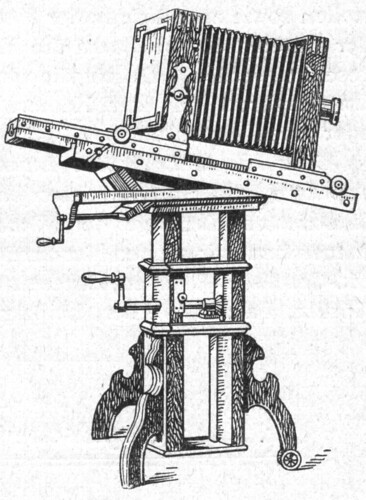
|
| studio camera in 1910 |
What about the cameras?
The cameras needed in the ancient daylight-depending studios had to have fast lenses. The fast Petzval lens was a standard for portrait photography. With the fast lenses used at wide apertures the still portraying style was found: sharpness plane on the face and blurred foreground and background. Big cameras were not necessary.
But the photographers wanted to show all their art, thus giving their studios the style of a theatre stage with changing settings. The photo subjects could feel like actors on a stage, playing a scene with statuary gesture for the moment of exposure, of course made at smaller aperture, needing a longer exposure time unless made with flash light. If people wanted , instead of a picture for the album, a big framed image for the living room, large format cameras were preferred instead of costly enlarging of small images. Thus big view cameras have become common in photo studios. If such cameras reach dimensions at which they must be seen as a piece of studio furniture they are pure studio cameras. The camera stand of such a camera is not just a tripod. It is a sturdy massive wooden construction including mechanics to regulate height and tilting of the camera.
Studio cameras might give exposures of 8×10 inches or dimensions like that, thus giving highest possible image resolution if taken ultimately sharp.
With the advent of high-end professional digital cameras, large format studio cameras are rarely seen in use anymore. However, a large format camera still can achieve greater quality than present studio digital cameras can hope for.
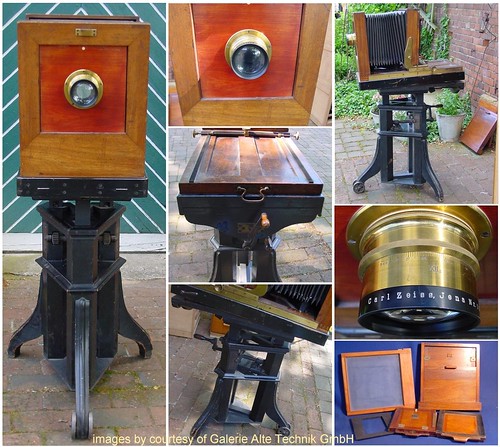
|
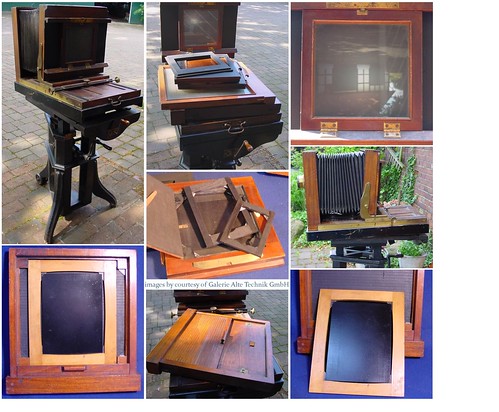 A studio camera of the same type as the one in the illustration above. The pictures show its accessories for the camera back: a hinged matte screen, a big film back with wooden rouleau, and adapters to use different plate sizes in that film back, smaller plate holders with adapters to adapt them to the camera back, and an alternate matte screen. |
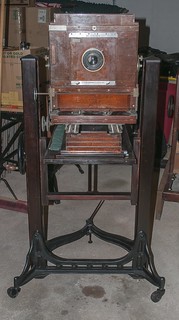
|
| 8x10 Deardorff image by Primo Iglesias (Image rights) |
What else is studio camera?
Since the early days smaller cameras play a leading role in studio photography, for example the Daguerreotyp-Apparat zum Portraitiren from 1840. Carte de Visite cameras (later Passport cameras) and smaller view cameras were always common in studios. In studios for advertising photos the interaction between photographer and model is more important, making hand cameras, mainly SLRs or modern professional digital cameras, the instrument of choice, combined with modern studio flashes. Other advertising studios don't photograph people but items of any kind for catalogues, brochures and so on, thus needing cameras with all kind of macro equipment and probably an additional monorail camera. But all these other camera types are not that kind of studio furniture like the above-mentioned super-large format view camera.
Conclusion
The kind of super-large view camera mentioned above is the only one which is made for the studio and for nothing but a studio, thus being the only one to be classified definitely as studio camera. Other studio cameras are smaller and more or less portable for applications outside of a studio. However they are classifiable otherwise.
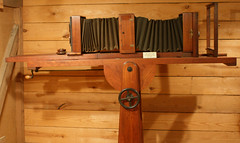
|
| old studio camera image by Patricia A. Murray (Image rights) |